4D Gaussian Splatting (and HexPlane)
4D Gaussian Splatting for Real-Time Dynamic Scene Rendering (CVPR 2024)
4D Gaussian Splatting for Real-Time Dynamic Scene Rendering
Guanjun Wu, Taoran Yi, Jiemin Fang, Lingxi Xie, Xiaopeng Zhang, Wei Wei, Wenyu Liu, Qi Tian, Xinggang Wang
paper :
https://arxiv.org/abs/2310.08528
project website :
https://guanjunwu.github.io/4dgs/index.html
code :
https://github.com/hustvl/4DGaussians
referenced blog :
https://xoft.tistory.com/54
핵심 요약 :
3DGS를 dynamic scene에 적용하고자 할 때
x, y, z, t를 input으로 갖는 encoder로서
4D scene을 2D planes로 표현하는 HexPlane 기법을 이용하겠다!
Abstract
-
spatially-temporally-sparse input으로부터
complex point motion을 정확하게 모델링하면서
high efficiency로 real-time dynamic scene을 rendering하는 건 매우 challenging task - 3DGS를 각 frame에 적용하는 게 아니라 4DGS라는 새로운 모델 제시
-
오직 3DGS 한 세트필요 - 4DGS framework :
-
Spatial-Temporal Structure Encoder:
HexPlane[22] 에서 영감을 받아
decomposed neural voxel encoding algorithm을 이용해서
4D neural voxel을 2D voxel planes로 decompose하여
2D voxel plane (param.)에 Gaussianpoint-clouds (pts)의 spatial-temporal 정보를 encode -
Extremely Tiny Multi-head Gaussian Deformation Decoder:
가벼운 MLP를 이용해서
Gaussian deformation을 예측함
-
-
- 4DGS :
real-time (82 FPS) rendering at high (800 \(\times\) 800) resolution on RTX 3090 GPU
Contribution
-
Gaussian
motion과shape-deformation을 모두 모델링할 수 있는 4DGS framework 제시
w. efficientGaussian deformation fieldnetwork -
multi-resolutionencoding
(only on spatial planes)
(connect nearby 3D Gaussians to build rich Gaussian features)
by efficientspatial-temporal structure encoder -
SOTA
performance이면서real-timerendering ondynamicscenes
e.g. 82 FPS at resol. 800 \(\times\) 800 for synthetic dataset
e.g. 30 FPS at resol. 1352 \(\times\) 1014 for real dataset -
4D scenes에서의 editing 및 tracking에 활용 가능
Related Works
Novel View Synthesis
- static scene :
- dynamic scene :
- NeRF-based methods
[11] [12] [13] -
explicit voxel grid[14] [15] [16] [17] :
temporal info. 모델링하기 위해 explicit voxel grid 사용 -
flow-basedmethods[18] [19] [16] [20] [21] :
nearby frames를 blending하는 warping algorithm 사용 -
decomposed neural voxels[22] [23] [24] [25] [26] [27] :
빠른 training on dynamic scenes 가능
(Fig 1.의 (b)) -
multi-viewsetups 다루기 위한 methods[28] [29] [30] [31] [32] [33] - 본 논문 (4DGS) :
위에서 언급된 methods는 빠른 training은 가능했지만 real-time rendering on dynamic scenes는 여전히 어려웠음
\(\rightarrow\)
본 논문은 빠른 training 및 rendering pipeline 제시
(Fig 1.의 (c))
- NeRF-based methods
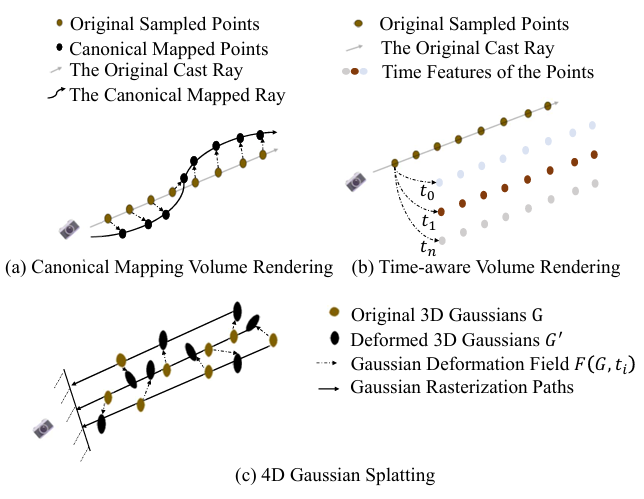
- Fig 1. 설명 :
dynamic scene을 rendering하는 여러 방법들 소개- (a) : Deformation-based (Canonical Mapping) Volume Rendering
point-deformation-field를 이용해서
sampled points를 canonical space로 mapping
(하나의 ray 위의 sampled points가 다같이 canonical space로 mapping되므로
각 point의 서로 다른 속도를 잘 모델링하지 못함) - (b) : Time-aware Volume Rendering
각 timestamp에서의 각 point의 feature를 직접 개별적으로 계산
(path는 그대로) - (c) : 4DGS
compactGaussian-deformation-field를 이용해서
기존의 3D Gaussians를 특정 timestamp의 3D Gaussians로 변환
((a)와 유사하긴 하지만
각 Gaussian이ray에 의존하지 않고 서로 다른 속도로 이동가능)
- (a) : Deformation-based (Canonical Mapping) Volume Rendering
Neural Rendering w. Point Clouds
-
3D scenes를 나타내기 위해 meshes, point-clouds, voxels, hybrid ver. 등 여러 분야가 연구되어 왔는데
그 중 point-cloud representation을 volume rendering과 결합하면
dynamic novel view synthesis task도 잘 수행 가능 -
3DGS :
explicitrepresentation이라서,
differentiablepoint-based splatting이라서,
real-timerenderer라서 주목받음 -
3DGS on dynamic scenes :
- Dynamic3DGS
[34] :- 3D Gaussian 개수를 고정하고
각 timestamp \(t_i\) 마다 각 3D Gaussian의 position, variance를 tracking - 문제점 :
- need dense multi-view input images
- prev. frame의 모델링이 부적절하면 전체적인 성능이 떨어짐
- linear memory consumption \(O(tN)\)
for \(t\)-time steps and \(N\)-3D Gaussians
- 3D Gaussian 개수를 고정하고
- 4DGS (본 논문) :
- very compact network로 3D Gaussian motion을 모델링하기 때문에
training 효율적이고 real-time rendering - memory consumption \(O(N+F)\)
for \(N\)-3D Gaussians, \(F\)-parameters of Gaussian-deformation-field network
- very compact network로 3D Gaussian motion을 모델링하기 때문에
- 4DGS (Zeyu Yang)
[35] :- marginal temporal Gaussian 분포를 기존의 3D Gaussian 분포에 추가하여
3D Gaussians를 4D로 uplift - However, 그러면 각 3D Gaussian은 오직 their local temporal space에만 focus
- marginal temporal Gaussian 분포를 기존의 3D Gaussian 분포에 추가하여
- Deformable-3DGS (Ziyi Yang)
[36] :- 본 논문처럼 MLP deformation network를 도입하여 dynamic scenes의 motion을 모델링
- 본 논문 (4DGS)도 이와 유사하지만 training을 효율적으로 만듦
- Spacetime-GS (Zhan Li)
[37] :- 각 3D Gaussian을 individually tracking
- Dynamic3DGS
Dynamic NeRF with Deformation Fields
-
모든 dynamic NeRF는 아래의 식을 따른다
\(c, \sigma = M(x, d, t, \lambda)\)
where \(c \in R^3, \sigma \in R, x \in R^3, d \in R^2, t \in R, \lambda \in R\)
where \(\lambda\) is optional input (frame-dependent code to build topological and appearance changes)[12] [38] -
deformation NeRF-based methods는
Fig 1. (a)에서처럼
deformation network \(\phi_{t} : (x, t) \rightarrow \Delta x\) 로 world-to-canonical mapping 한 뒤
RGB color와 volume density를 뽑는다
\(c, \sigma = NeRF(x+\Delta x, d, \lambda)\) -
4DGS (본 논문)은
Gaussian deformation fieldnetwork \(F\) 이용해서
time \(t\) 에서의canonical-to-world mapping을 직접 계산한 뒤
differential splatting(rendering) 수행
Method
Overview (Gaussian Deformation Field Network)

- Fig 2. 설명 :
- static 3D Gaussian set을 만듦
- 각 3D Gaussian의 center 좌표 \(x, y, z\) 와 timestamp \(t\) 를
Gaussian Deformation Field Network의 input으로 준비 - Spatial-Temporal Structure Encoder :
multi-resolution voxel planes를 query하여
voxel feature를 계산
(temporal 및 spatial feature를 둘 다 encode 가능) - Tiny Multi-head Gaussian Deformation Decoder :
position, rotation, scaling head에서 각각 해당 feature를 decode하여
각 3D Gaussian의 position, rotation, scaling 변화량을 얻어서
timestamp \(t\) 에서의 변형된 3D Gaussians를 얻음
Spatial-Temporal Structure Encoder
-
근처에 있는 3D Gaussians끼리는 항상 spatial 및 temporal 정보를 비슷하게 공유하고 있다.
따라서 HexPlane 기법에서는 각 Gaussian이 따로 변형되는 게 아니라,
여러adjacent 3D Gaussian들이 군집처럼 연결되어 함께 변형되므로
motion과 shape-deformation을 정확하게 예측할 수 있다
이로써 변형된 geometry를 더 정확히 모델링하고 avulsion(벗겨짐?)을 방지할 수 있음 -
기존 논문 설명 (Backgrounds) :
- TensoRF : Link
- HexPlane
[22] :
4차원(\(XYZT\))을 모델링하기 위해
3개 타입의 rank로 decomposition (\(XY\) 평면 - \(ZT\) 평면, \(XZ\) 평면 - \(YT\) 평면, \(YZ\) 평면 - \(XT\) 평면)
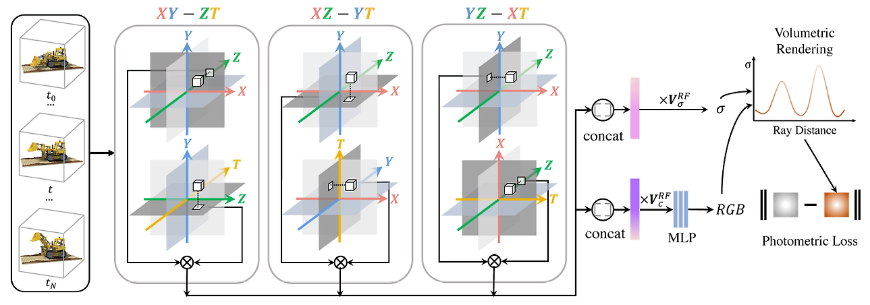
- Spatial-Temporal Structure Encoder (1) :
- vanilla 4D neural voxel은 memory를 많이 잡아먹기 때문에
4D neural voxel(\(XYZT\))을 6개의 multi-resol. planes로 decompose하는
4D K-Planes module[23] 사용 - 3D Gaussians는 bounding plane voxels에 포함되어
Gaussians의 deformation도 nearby temporal voxels에 encode될 수 있음???? - 기존 논문들
[14] [22] [23] [26] 에서 영감을 받아
Spatial-Temporal Structure Encoder는
multi-resolution HexPlane \(R(i, j)\) 와 tiny MLP \(\phi_{d}\) 로 구성됨
- vanilla 4D neural voxel은 memory를 많이 잡아먹기 때문에
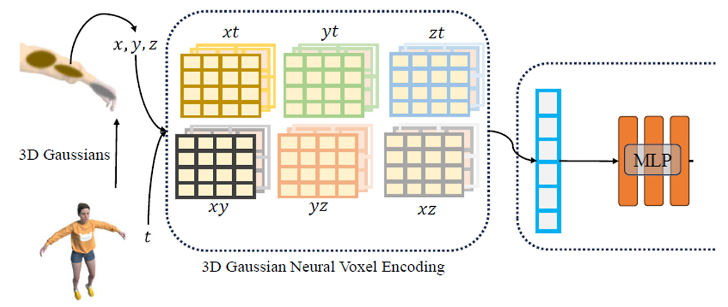
- Spatial-Temporal Structure Encoder (2) :
- multi-resolution HexPlane \(R(i, j)\) :
본 논문에서는 TensoRF와 달리 Grid resol.을 점점 증가시키지 않고, 애초에 multi-resolution으로 decomposition의 rank를 구성함
\(f_{h} = \cup_{l} \prod \text{interp}(R_{l}(i, j))\)- where
\(f_h \in R^{h \ast l}\) : feature of decomposed neural voxel
\(R_{l}(i, j) \in R^{h \times lN_i \times lN_j}\) : 2D voxel plane (nn.Parameter())
\(h\) : hidden dim.
\(\{ i, j \} \in \{ (x, y), (x, z), (y, z), (x, t), (y, t), (z, t) \}\) : 6 종류의 planes
\(N\) : voxel grid의 basic resol.
\(l \in \{ 1, 2 \}\) : upsampling scale (multi-resol.)
\(\text{interp}\) : bilinear interpolation (plane의 grid의 네 꼭짓점으로부터 interpolation으로 voxel feature 뽑아냄)
\(\prod\) : product over planes (K-Planes[23] 참고)
\(\cup_{l}\) : multi-resol.에 대해 concat 또는 add - Github Code 에서
- forward()
- get_density()
- self.grids : multi-resol. HexPlane
즉, nn.ModuleList() of init_grid_param() - init_grid_param() : HexPlane
즉, nn.ParameterList() of nn.Parameter()
where
range(in_dim) = [0, 1, 2, 3] (x, y, z, t) 중에 grid_nd = 2개의 조합(plane)을 뽑아서
각 nn.Parameter()는 2D grid plane \(R_{l}(i, j)\) for \(\{ i, j \} \in \{ (x, y), (x, z), (y, z), (x, t), (y, t), (z, t) \}\)
w. shape \((1, D_{out}, \text{resol.}[j], \text{resol.}[i])\)
e.g. \(R_{l}(x, t)\), 즉 \(XT\) plane은 nn.Parameter()
w. shape \((1, D_{out}, \text{resol.}[3], \text{resol.}[0])\)
- self.grids : multi-resol. HexPlane
- interpolate_ms_features() : \(f_{h} = \cup_{l} \prod \text{interp}(R_{l}(i, j))\) 반환
- grid_sample_wrapper() : \(\text{interp}(R_{l}(i, j))\) 반환
- grid_sampler() : F.grid_sample() Link
second argument(pts) 좌표에서의 값을 구하기 위해 first argument(grid \(R_{l}(i, j)\))의 값을 interpolate
그럼 이제 dynamic 3D scene을4D neural voxel대신2D voxel plane\(R_{l}(i, j)\) 이라는 param.들로 표현 가능
- where
- multi-resolution HexPlane \(R(i, j)\) :
- Spatial-Temporal Structure Encoder (3) :
- tiny MLP \(\phi_{d}\) :
\(f_d = \phi_{d} (f_h)\)
merge all the features - 공간상(e.g. \(XY\) 평면) 또는 시간상(e.g. \(XT\) 평면)으로 인접한 voxel은
HexPlane \(R(i, j)\) 에서 유사한 feature를 가져서 유사한 Gaussian param. 변화량을 가지므로
optimization 진행됨에 따라
Gaussian의 covariance가 줄어들면서 작은 3D Gaussian들이 모여서 dense해진다?????
- tiny MLP \(\phi_{d}\) :
Extremely Tiny Multi-head Gaussian Deformation Decoder
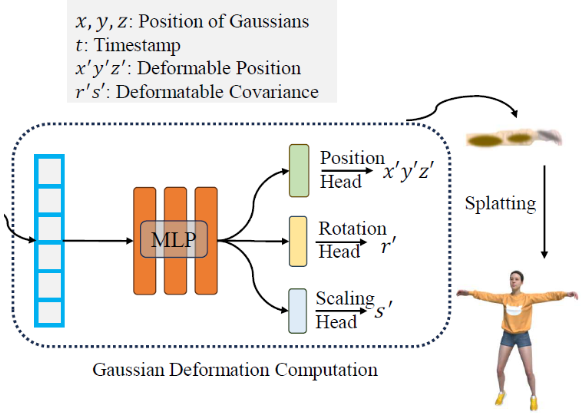
- Multi-head Gaussian Deformation Decoder :
- 매우 작은 multi-head decoder로 position, scaling, rotation 변화량을 얻음
\(\Delta \chi = \phi_{x}(f_d)\)
\(\Delta r = \phi_{r}(f_d)\)
\(\Delta s = \phi_{s}(f_d)\) - 그러면 변형된 deformed 3D Gaussians 계산할 수 있음
\((\chi ' , r ' , s ') = (\chi + \Delta \chi, r + \Delta r, s + \Delta s)\) 에 대해
next time \(t\) 의 deformed 3D Gaussian set은
\(G ' = \{ \chi ' , r ' , s ', \sigma, c \}\) - 근데 실제 implementation 할 때는 speed 증가 위해
scaling(size), rotation, color, opacity는 고정하고
position 변화량만 구함 - Github Code 에서
- Class deform_network()의 forward_dynamic()
- Class Deformation()의 forward_dynamic()
- hidden : encoder(HexPlane과 MLP) 거쳐 얻은 feature
- self.pos_deform, self.scales_deform, self.rotations_deform : tiny Multi-head decoder
hidden으로부터 \(\Delta \chi, \Delta r, \Delta s\) 얻음 - self.static_mlp :
hidden으로부터 \(\text{mask}\) 얻음 - position :
\(\chi ' = \gamma(\chi) \times \text{mask} + \Delta \chi\) - scaling :
\(s ' = \gamma(s) \times \text{mask} + \Delta s\) - rotation :
\(r ' = \gamma(r) + \Delta r\)
또는
\(r ' =\) quaternion product of \(\gamma(r)\) and \(\Delta r\) - opacity, SH 도 deform 가능하게 짜놓긴 함
\(\alpha ' = \alpha \times \text{mask} + \Delta \alpha\)
\(k ' = k \times \text{mask} + \Delta k\)
- 매우 작은 multi-head decoder로 position, scaling, rotation 변화량을 얻음

self._deformation = deform_network(args)
Optimization
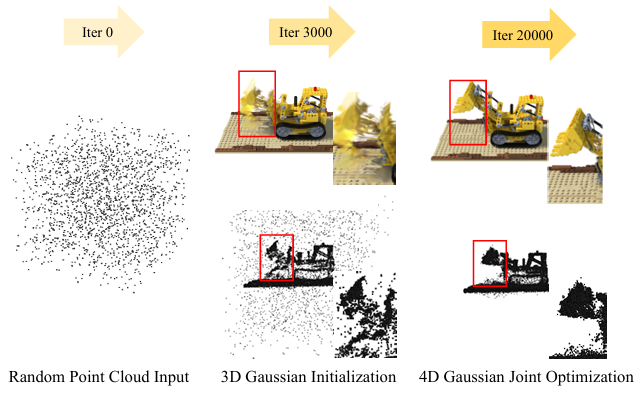
-
warm-up:
처음 3000 iter. 동안은
Gaussian Deformation Field Network 없이
3DGS의 SfM points initialization 이용하여
static 3DGSoptimize 하고,
그 후에 dynamic scene에 대해 4DGS framework를 fine-tuning 형태로 학습 -
Loss :
\(L = | \hat I - I | + L_{tv}\)- L1 recon. loss
-
total-variational loss:- sparse input images일 경우에 적게 관측된 view에서는 noise 및 outlier 때문에 overfitting 및 local minima 문제가 발생할 수 있으므로
regularizationterm 필요 - pixel 값 간의 급격한 변화를 억제하기 위해
\(I_{i+1, j} - I_{i, j}\) 항과 \(I_{i, j+1} - I_{i, j}\) 항을 loss에 추가
- sparse input images일 경우에 적게 관측된 view에서는 noise 및 outlier 때문에 overfitting 및 local minima 문제가 발생할 수 있으므로
Experiment
-
single RTX 3090 GPU
-
Synthetic Dataset :
- designed for monocular settings
- camera poses for each timestamp은 거의 randomly generated 수준
- scene 당 50-200 frames
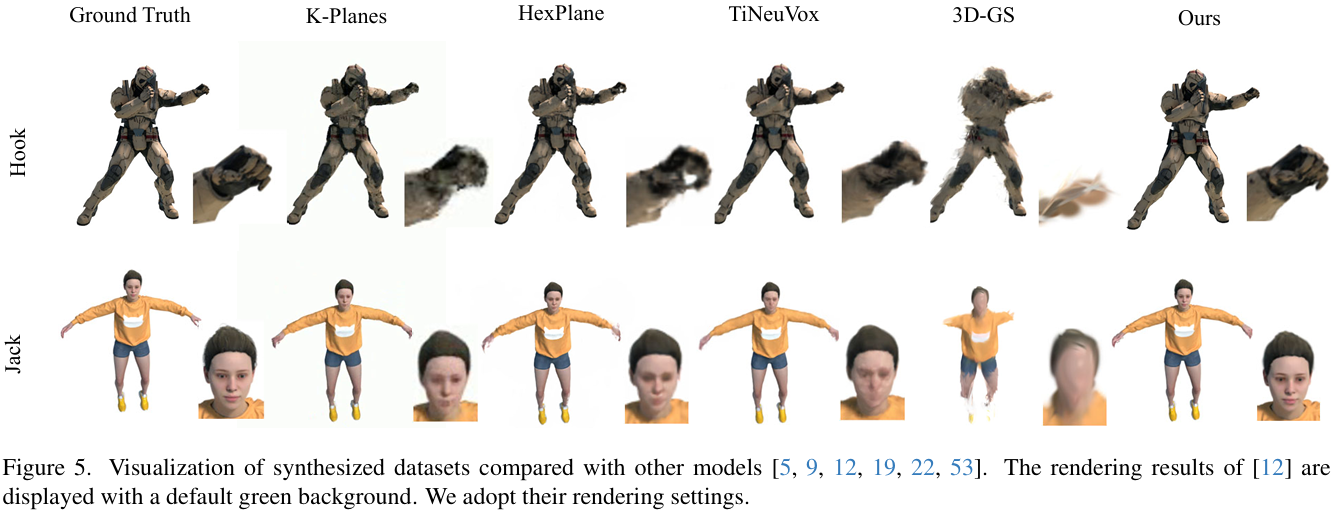
- Real-world Dataset :
- by HyperNeRF
[12] and Neu3D[25] - HyperNeRF dataset :
one or two cameras
with straightforward camera motion
(1,2개의 camera를 직관적인 경로로 움직이며 촬영) - Neu3D dataset :
15 to 20 static cameras
with extended periods and complex camera motions
(15-20개의 많은 정적인 camera로 오랜 시간 동안씩 촬영하며 복잡한 경로로 camera를 움직임)
- by HyperNeRF
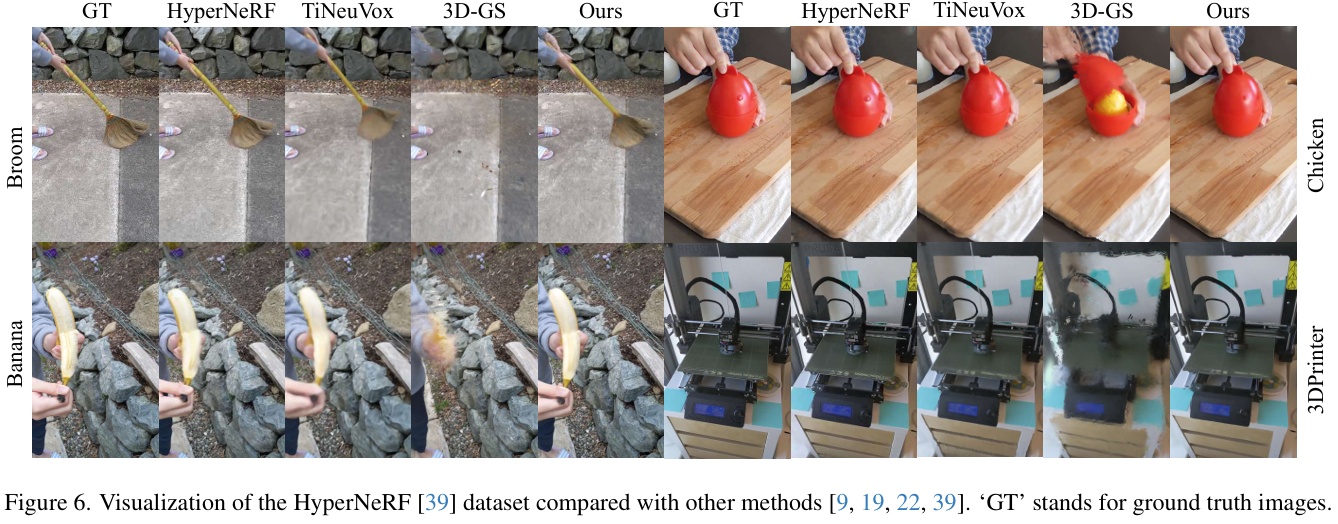
Results
- Metrics :
- quality :
PSNR
LPIPS
SSIM
DSSIM
MS-SSIM - speed :
FPS
training times - memory :
storage
- quality :

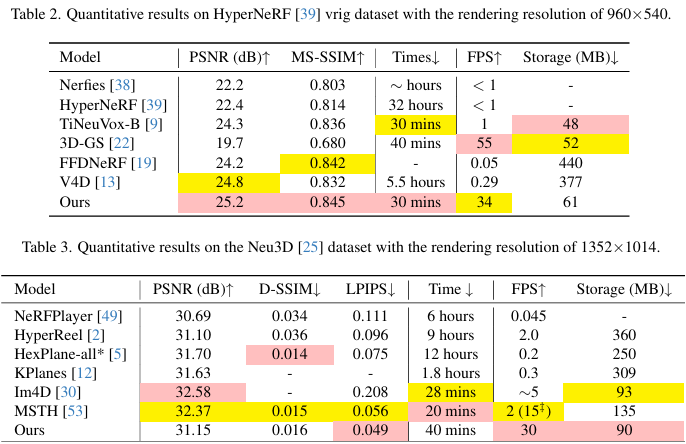
- Im4D
[29] 는 본 논문과 유사하게 high-quality이지만
multi-cam 방식을 쓰기 때문에 monocular scene을 모델링하기 어렵
Ablation Study

- Spatial-Temporal Structure Encoder :
- explicit HexPlane encoder는
3DGS의 spatial 및 temporal 정보를 모두 encode 하면서
purely explicit method[34] 보다 storage 공간 아낄 수 있음 - 만약에 HexPlane encoder 없이 shallow MLP encoder만 쓰면
복잡한 deformation 모델링 어렵
- explicit HexPlane encoder는
- 3D Gaussian Initialization :
- 처음에 warm-up으로 SfM points initialization 한 뒤 static 3DGS optimize 부터 해야
아래의 장점들 있음- 3DGS 일부가 dynamic part에 분포되도록 함
- 3DGS를 미리 학습해야 deformation field가 dynamic part에 더 집중 가능
- deformation field 학습 시 numerical errors를 방지하여 훈련 과정이 더 stable
- 처음에 warm-up으로 SfM points initialization 한 뒤 static 3DGS optimize 부터 해야
- Multi-head Gaussian Deformation Decoder :
- 3D Gaussian motion을 modeling함으로써 dynamic scene을 잘 표현할 수 있도록 해줌

- Neural Voxel Encoder :
- implicit MLP-based neural voxel encoder (voxel grid)가 아니라
explicit Dynamic 3DGS 기법을 사용할 경우
rendering quality는 떨어지지만 FPS 및 storage는 향상
- implicit MLP-based neural voxel encoder (voxel grid)가 아니라
- Two-stage Training :
- static 3DGS stage \(\rightarrow\) dynamic 4DGS stage (fine-tuning) 으로
분할해서 학습할 경우 성능 향상
(참고로 D-NeRF, DyNeRF에서는 point-clouds가 주어지지 않아서 어려운 task를 다룸)
- static 3DGS stage \(\rightarrow\) dynamic 4DGS stage (fine-tuning) 으로
- Image-based Loss :
- LPIPS loss, SSIM loss 같은 image-based loss를 사용할 경우
training speed도 느려지고 quality도 떨어짐 - 그 이유는
image-based loss로 motion 부분을 fine-tuning하는 건 어렵고 복잡
- LPIPS loss, SSIM loss 같은 image-based loss를 사용할 경우
- Model Capacity (MLP size) :
- voxel plane resol. 또는 MLP 크기가 증가할수록
quality 향상되지만 FPS 및 storage 악화
- voxel plane resol. 또는 MLP 크기가 증가할수록
- Fast Training :
- 7k iter. 까지만 학습해도(training 시간 짧음) 괜찮은 PSNR 달성
Discussion
- Tracking with 3D Gaussians :
- Dynamic3DGS
[34] 와 달리
본 논문은 monocular setting에서도 low storage로 3D object tracking 가능
(e.g. 10MB for 3DGS and 8MB for deformation field network)
- Dynamic3DGS
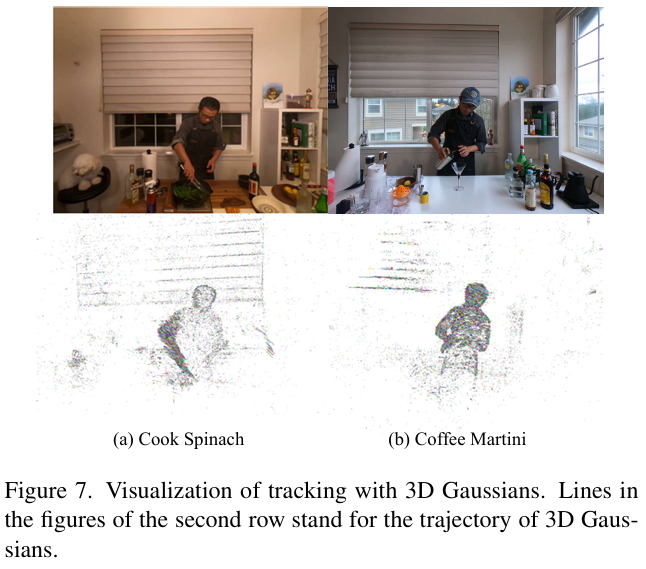
- Composition(Editing) with 4D Gaussians :
- Dynamic3DGS
[34] 에서처럼
4DGS editing 가능
- Dynamic3DGS
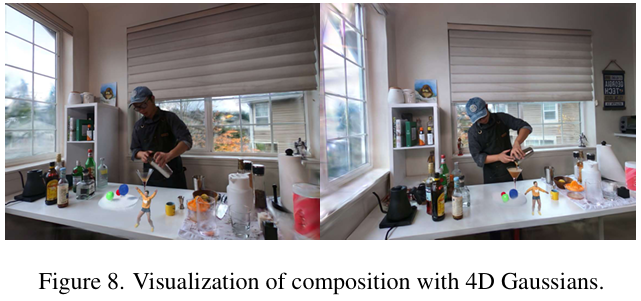
- Rendering Speed (FPS) :
- 3DGS 수와 FPS는 반비례 관계인데
Gaussians 수가 30,000개 이하이면 single RTX 3090 GPU에서 90 FPS 까지 가능 - 이처럼 real-time FPS를 달성하려면
resolution, Gaussian 수, Gaussian deformation field network 용량, hardware constraints 등 여러 요인을 조절해야 함
- 3DGS 수와 FPS는 반비례 관계인데
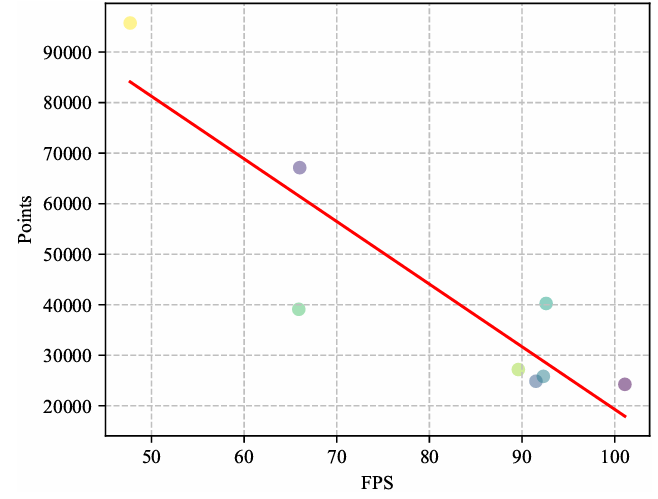
Limitation
- 아래의 경우엔 학습 잘 안 됨
-
large motions일 경우 -
background points가 없을 경우 -
camera pose가unprecise(부정확)할 경우
-
-
추가적인 supervision 없이
staticGaussians와dynamicGaussians의 joint motion을 구분하는 건 아직 어려운 과제 -
urban(large)-scalerecon.일 경우엔
3DGS 수가 훨씬 많아서
Gaussian deformation field network를 query하기에 너무 무거우므로 좀 더 compact한 algorithm이 필요
Conclusion
-
4DGS framework for
real-timedynamicscene rendering - efficient deformation field network to model motions and shape-deformation
- Spatial-temporal structure encoder :
adjacent Gaussians가 비슷하게 encode되도록 spatial-temporal 정보를 encode - Multi-head Gaussian deformation decoder :
position, scaling, rotation을 각각 modeling
- Spatial-temporal structure encoder :
- dynamic scenes 모델링 뿐만 아니라
4D object tracking 및 editing에도 활용 가능
Question
- Q1 : 본 논문을 한 문장으로 요약하자면,
3DGS를 dynamic scene에 적용하고자 할 때 4D 정보를 효율적으로 encode하기 위해 2D planes로 scene을 표현하는 HexPlane 기법을 이용하겠다!인데,
본 논문이 novelty가 있는지 의구심이 듭니다. -
A1 : 3DGS 논문 자체가 나온 지 얼마 안 돼서
기존 논문(HexPlane) 아이디어를 3DGS에 적용하는 논문들이 아직까지는 많이 채택되는 것 같다. - Q2 : 본 포스팅에서 코드 리뷰는 encoder (HexPlane) 쪽만 진행하였는데,
Multi-head Gaussian deformation decoder로 position, scaling, rotation 변화량을 구해서
Deformed(변형된) 3DGS를 구하는 부분의 코드도 보고 싶습니다. - A2 : 포스팅의 “Extremely Tiny Multi-head Gaussian Deformation Decoder” 부분에 해당 내용을 추가하였습니다.
Appendix
- TBD